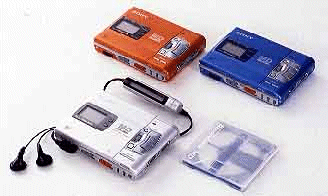Explore
the origions
of minidisc
how to buy
into the product
and what
to buy
plus where
now?
Reviews
Sony MZR50
Sharp MS 701/2
Mini Reviews
Awia AM-R10
Panasonic SJ-MJ70
Panasonic SJ-MR100
Sharp MS722
Sharp MT821
Sony MZR55
 |
|||
RECORDING AND EDITING This is were in my opinion the player really makes and breaks it. Firstly on a good note is that it comes readily supplied with an optical cable for real digital copying (these can cost around £20 alone). However no analogue cable is supplied, so if your CD player doesn't have an optical out your have to purchase this separately (only a couple of quid though). Once the player is hocked up to a device recording isn't the simplest thing when you first come to tackle it (especially compared to the Sharp 701), but you soon get ues to it. There are several things that I should point out though.
Finally there's editing. Which I have to say works very well on this model. Titling is easy with the wheel, it lets you quickly browse through the alphabet with ease. However dividing and merging the tracks is slightly more annoying, (again using the fiddly buttons) but you soon get used to it. Overall this is a good player with a few annoying faults, but most people will be able to overlook them. It's durable and should last for ages being made by Sony with great build quality and looks. However it's not the cheapest player, and there are now newer and smaller models out, but nevertheless a good first (or anytime) buy. Looks
and Useability |
|||
 Handily
the level of sound recording is automatically
adjusted for you when you start recording, but if
you wish you can do this manually. However once
recording, you can't adjust these levels with out
pausing the player, but this shouldn't be too
much of a problem unless you're recording live.
If this is important to you though, you should
also be warned that there's no real decible meter
when recording, only Sonys own meter bar. What is
really disappointing though is the lack of a line
synchro feature (which means the player starts
recording when you start playing the source) in
analogue recording. This means you have to
manually start both sources at the same time.
Another annoying feature is the End Search
button. You see the R50 refuses to record from
the end of the last track without pressing this
button. If you don't (or forget) to press it then
it starts recording at the beginning over what's
already there. However it makes up for this if
your want to start record in hurry. When you
first insert a disk it takes several seconds for
it to read the TOC (table of contents). But if
you press the record button while its doing this
it will record into the memory, and then spool it
onto the disk. Great. If you want to record from
a mic then there are two settings to choose for
the mic sensitivity, only high and low- which
again isn't too bad for most, but it does stamp
the date and time of what's recorded on the disk.
Also like nearly all recordable players it marks
the track in analogue recording if there's a
blank space for 3 seconds (in digital tracks are
automatically marked) and you can record in mono.
There is again like most players no digital out,
but there it does use a line out (instead of the
headphone socket), so you can listen while
playing the signal out (although its unlikely
your want to do that).
Handily
the level of sound recording is automatically
adjusted for you when you start recording, but if
you wish you can do this manually. However once
recording, you can't adjust these levels with out
pausing the player, but this shouldn't be too
much of a problem unless you're recording live.
If this is important to you though, you should
also be warned that there's no real decible meter
when recording, only Sonys own meter bar. What is
really disappointing though is the lack of a line
synchro feature (which means the player starts
recording when you start playing the source) in
analogue recording. This means you have to
manually start both sources at the same time.
Another annoying feature is the End Search
button. You see the R50 refuses to record from
the end of the last track without pressing this
button. If you don't (or forget) to press it then
it starts recording at the beginning over what's
already there. However it makes up for this if
your want to start record in hurry. When you
first insert a disk it takes several seconds for
it to read the TOC (table of contents). But if
you press the record button while its doing this
it will record into the memory, and then spool it
onto the disk. Great. If you want to record from
a mic then there are two settings to choose for
the mic sensitivity, only high and low- which
again isn't too bad for most, but it does stamp
the date and time of what's recorded on the disk.
Also like nearly all recordable players it marks
the track in analogue recording if there's a
blank space for 3 seconds (in digital tracks are
automatically marked) and you can record in mono.
There is again like most players no digital out,
but there it does use a line out (instead of the
headphone socket), so you can listen while
playing the signal out (although its unlikely
your want to do that).